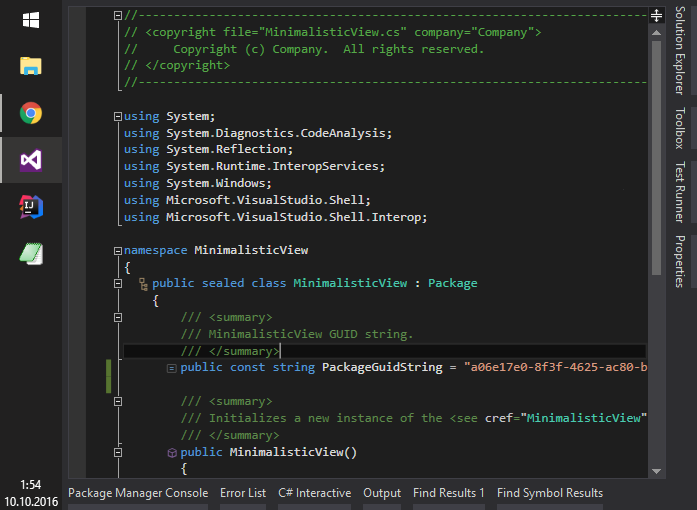

- VISUAL STUDIO PACKAGE MANAGER CONSOLE SHORTCUT UPDATE
- VISUAL STUDIO PACKAGE MANAGER CONSOLE SHORTCUT CODE
- VISUAL STUDIO PACKAGE MANAGER CONSOLE SHORTCUT PASSWORD
- VISUAL STUDIO PACKAGE MANAGER CONSOLE SHORTCUT PLUS
- VISUAL STUDIO PACKAGE MANAGER CONSOLE SHORTCUT DOWNLOAD
Execute PL/SQL: From menu, select Run to execute a stored procedure or function. VISUAL STUDIO PACKAGE MANAGER CONSOLE SHORTCUT CODE
In Visual Studio Code menu select File->Save As and then click Show Local. Alternatively, after opening the package, procedure, function, or trigger from Database Explorer select the tab with the PL/SQL code in it.
Save PL/SQL to file: In Oracle Database Explorer right click a package, procedure, function, or trigger and from the menu and select Download. (Note: these menu names were previously named Edit PL/SQL and Save to Database in earlier releases.) If there are errors when saving, they will be listed in the Problems panel, and you can click on an error to go to the line that contains the error. Save PL/SQL to database: If the PL/SQL was opened with the Open menu item in Database Explorer, you can save changes to the database by right clicking in the PL/SQL code and selecting Save. See Edit Existing PL/SQL in your Database below for more details. Edit PL/SQL: On stored procedures, functions, packages, or trigger nodes select Open/Open Package Body/Open Specification to open PL/SQL into a file for editing. View metadata for a schema object (describe): On any schema object node, right click and select the Describe menu item. The SQL will be added to an open SQL script file that is selected, or a new SQL file will be opened containing the SQL. Generate SELECT, INSERT, or DELETE statements for a table: On a Table node, right click and select Generate Select SQL, Generate Insert SQL, or Generate Delete SQL from the menu. For more information see View and Save Result Sets below. View and Save Table/View Data: On a Table and View node's menu, select Show Data. In the connection dialog, check the Show more options checkbox then select a different schema in the Current Schema dropdown. Alternately, click on the connection node and select Update. View Other Users/Other Schemas: Click to expand the Other Users node. Disconnect: Right click on any connection node and select Disconnect. VISUAL STUDIO PACKAGE MANAGER CONSOLE SHORTCUT UPDATE
Update Connection info: Right click on any connection node and select Update. Delete Connection: Right click on any connection node and select Delete. Once connection nodes display, you can click on the node to view the database schema. VISUAL STUDIO PACKAGE MANAGER CONSOLE SHORTCUT PLUS
Connect: Click the plus sign button to create a new connection, following the steps below to Connect to Oracle Database or Connect using a TNSNAMES.ORA Connection Alias. To view Database Explorer, click the database icon in the Activity Bar on the far left side of Visual Studio Code. To refresh the tree control, click on any item and select Refresh. VISUAL STUDIO PACKAGE MANAGER CONSOLE SHORTCUT PASSWORD
To change the ADMIN password for an ADB, right click on database icon and select Change Administrator Password.To Terminate an ADB, right click on database icon and select Terminate.To Stop an ADB, right click on database icon and select Stop.To Start an ADB, right click on database icon and select Start.

VISUAL STUDIO PACKAGE MANAGER CONSOLE SHORTCUT DOWNLOAD
To only download credentials files, right click on database icon and select Download Credentials Files. To create a connection in Database Explorer and optionally download credentials files right click on database icon and select Create Connection in Database Explorer. Icons containing a D are dedicated instances. Icons with a green star are Always Free databases. Database icons with a red ball are not available, those with a yellow ball are starting or stopping, and icons with no ball are available. Change the region or compartment if your databases are not shown. To view an existing database, expand Autonomous Transaction Processing Databases, Autonomous Data Warehouses, or Autonomous JSON Databases and view the list of databases. 
To create a new Autonomous Database (ADB), including an Always Free ADB, right click on Autonomous Transaction Processing Databases, Autonomous Data Warehouses, or Autonomous JSON Databases and select Create New.To change the compartment or region: Right click on the profile name (usually DEFAULT) and select Change Compartment or Region from the menu.Follow these instructions to create an Oracle Cloud account, generate the required config file and key files, and connect the Oracle Cloud Infrastructure Explorer tree control to the Oracle Cloud.







 0 kommentar(er)
0 kommentar(er)
